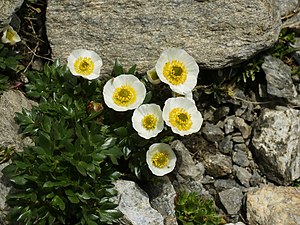Glacier buttercup
| Glacier buttercup | ||||||||||||
|---|---|---|---|---|---|---|---|---|---|---|---|---|

Glacier buttercup ( Ranunculus glacialis ) |
||||||||||||
| Systematics | ||||||||||||
|
||||||||||||
| Scientific name | ||||||||||||
| Ranunculus glacialis | ||||||||||||
| L. |
The glacier buttercup ( Ranunculus glacialis ) is a particularly tall plant species from the buttercup family (Ranunculaceae).
description
The glacier buttercup is a wintering green, perennial , herbaceous plant that reaches heights of 5 to 20 centimeters. The plant parts are mostly bare. The hand-shaped leaves are petiolate at the base. They are shiny, fleshy, and have three to five roughly blunt-toothed lobes. The stem leaves are sessile and less deeply divided with lanceolate tips.
The color of the flowers changes from initially white to pink to dark red and they have a diameter of 3 centimeters. A rust-brown hair covers the outside of the sepals . The crown and calyx do not fall off when they fade and remain until the fruit ripe - in contrast to all other buttercups. The flowering period extends from July to August.
The glacier buttercup is diploid and the number of chromosomes is 2n = 16.
ecology
The glacier buttercup is a hemicryptophyte . It often grows under the shelter of ice overhangs that act like a glass house, which has made it one of the highest ascending plants. The glacier buttercup is one of the most physiologically studied alpine plants.
This type of plant needs two to three growing seasons before it can flower. Despite the extremely frost-prone locations, the glossy green leaves show no visible climatic adaptations. This may be due to a frost resistance of the protoplasm .
In unfavorable summers, the reserve substances from the leaves are shifted back to the roots and buds that have already formed are broken down again.
The mostly homogamous flowers are pollinated by flies .
The fruits are flat, winged nuts that spread like glider pilots in an adhesive manner; In addition, processing is spread, for example by snow finches.
The glacier buttercup, like all other buttercups, is poisonous.
Occurrence
This species is mainly found in the central chain of the Alps as well as in the Pyrenees , Carpathians , Scandinavia and the Arctic . In the Alps, low-lime rubble, moraines , scree and bare rock at altitudes from 2300 m to over 4200 m ( Finsteraarhorn ) are preferred. It thrives on fresh, nutrient-poor and lime-poor, more or less raw, loose, sometimes agitated, silicate rubble soils. It is a species of character of the order Androsacetalia alpinae and likes to appear together with the alpine sourling ( Oxyria digyna ). In the Allgäu Alps in Bavaria on the Linkerskopf it rises from 1950 up to 2450 meters above sea level and occurs there together with the creeping clove root ( Geum reptans ).
literature
- Xaver Finkenzeller: Alpine flowers. Recognize & determine , Mosaik-Verlag, Munich 2002, ISBN 3-576-11482-3 .
- Wolfgang Adler, Karl Oswald, Raimund Fischer: Excursion flora of Austria. Ed .: Manfred A. Fischer . Ulmer, Stuttgart / Vienna 1994, ISBN 3-8001-3461-6 .
Individual evidence
- ↑ Jaakko Jalas, Juha Suominen: Atlas florae europaeae . Volume 8 (Nymphaeaceae to Ranunculaceae). Helsinki 1989, ISBN 951-9108-07-6 , p. 194.
- ↑ a b Ruprecht Düll , Herfried Kutzelnigg : Pocket dictionary of the plants of Germany and neighboring countries. The most common Central European species in portrait. 7th, corrected and enlarged edition. Quelle & Meyer, Wiebelsheim 2011, ISBN 978-3-494-01424-1 .
- ^ Erich Oberdorfer : Plant-sociological excursion flora for Germany and neighboring areas . With the collaboration of Angelika Schwabe and Theo Müller. 8th, heavily revised and expanded edition. Eugen Ulmer, Stuttgart (Hohenheim) 2001, ISBN 3-8001-3131-5 , pp. 416 .
- ↑ Erhard Dörr, Wolfgang Lippert : Flora of the Allgäu and its surroundings. Volume 1, IHW, Eching 2001, ISBN 3-930167-50-6 , p. 550.
Web links
- Glacier buttercup. In: FloraWeb.de.
- Glacier buttercup . In: BiolFlor, the database of biological-ecological characteristics of the flora of Germany.
- Profile and distribution map for Bavaria . In: Botanical Information Hub of Bavaria .
- Ranunculus glacialis L. In: Info Flora , the national data and information center for Swiss flora . Retrieved October 20, 2015.
- Distribution map worldwide
- Thomas Meyer: Data sheet with identification key and photos at Flora-de: Flora von Deutschland (old name of the website: Flowers in Swabia )
- Climate change endangers plants. In: daily newspaper. April 11, 2006. (about decline in glacier buttercup in connection with climate change)


